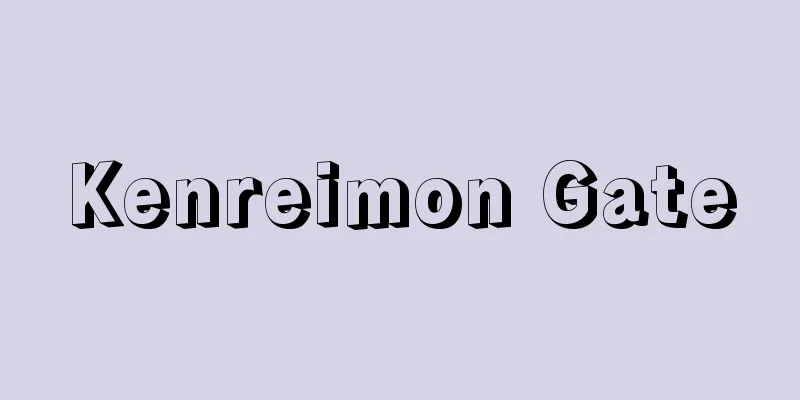Norm (English spelling)

|
In the broadest sense, a standard is one that commands people to "do" or "not do" certain things. The purpose is to specify what should be done by people in a particular situation and realize certain values, so the types of norms are divided according to what the ultimate value is. There are logical norms for proving the truth, ethical or moral norms for realizing the good, artistic norms for beauty, religious norms for faith, and social norms for realizing order in society. Here, we will discuss social norms. Of course, there are inherent social norms, but other norms, especially moral and religious norms, often have the nature of social norms at the same time, so social norms can include them or can simply be called norms. Social norms in this sense consist of the following four elements, and each of them can also be called a social norm in the narrow sense. [Masashi Chiba] Social normsThe first major element of social norms is the value principle. This is centered on ultimate values, and the various values associated with it often form a value system as a whole, and the forms and types of these systems are diverse in human society, and therefore, various types of social norms are found historically, socially, religiously, and culturally. The second element is behavioral patterns, which are generally repeated behaviors in society that are specified as patterns, but the specific forms and degrees of specificity vary. The third element, sanctions, are some kind of social pressure or authority that evaluates behavior and takes corresponding action of approval or disapproval to guarantee the behavioral pattern, but the legitimacy and organizational types of this pressure and authority are also diverse. The fourth element, rules or norms, are the overall expression of the above three elements in linguistic propositions, especially in writing. However, such linguistic expressions are formal elements, so the substance of social norms is determined by the previous three elements. [Masashi Chiba] Classification of social normsThe classification of social norms shared by Sumner and Weber is understood to have taken these three elements into consideration. First, customs are those that are established as patterns of behavior, but with uncertain value principles and unspecified sanctions. Second, mores are those in which value principles are established and therefore sanctions are specified. Finally, law is those in which sanctions are institutionalized by a specific institution, and therefore patterns of behavior are clear and value principles are systematically organized in a special way. Within each of these, there are various continuous stages, and in addition to modern state law, which is the most organized, there are many other types of law, such as official religious law, minority law, and unofficial law called customary law, indigenous law, living law, primitive law, and folklore, as well as the voluntary rules of large and small organizations in modern society. The above three classifications are also actually continuous, so if we focus on the specificity of the patterns of behavior as a whole, we call it custom, and if we understand it as the traditional lifestyle of ordinary people, such as food, clothing, and shelter, we call it folklore. However, in these cases, organized state law and religious law are excluded. [Masashi Chiba] The function of social normsSocial norms have two functions: a social aspect, which maintains order if followed, and thus keeps society alive, and a personal aspect, which means that if people follow them, they will be safe and be able to achieve their desires. Therefore, as long as society exists, social norms are often internalized in people's minds as a matter of course and are not consciously recognized, which can be said to be more effective. However, this is nothing but a tendency toward conservatism, and the power of human life, which feels that these are unjust restrictions, erupts and often leads to conscious resistance to existing social norms and reforms. Such norm conflicts occur constantly among infinitely diverse types, but also in the succession of certain norms over time. Social norms do not exist in an immovable form as established norms, but are always faced with such conflicts, and they survive only because they overcome them or compromise with them, and sometimes are replaced. Those that do not undergo this test become conventional and will eventually disappear. [Masashi Chiba] "Modern Sociology 3: Folkways" by S.W.G. Sumner, translated by Kiyotaka Aoyagi et al. (1975, Aoki Shoten) " "Sociology of Law" by M. Weber, translated by Koshiro Sera (1974, Sobunsha) [Reference] | | | | | |Source: Shogakukan Encyclopedia Nipponica About Encyclopedia Nipponica Information | Legend |
|
最広義には、人に一定のことを「すべし」、もしくは「すべからず」と命ずる規準。その目的は、特定の状況において人に当為を指定して一定の価値を実現するためであるから、究極的価値がなんであるかによって、規範の種類も分かれる。真を論証するための論理規範、善を実現するための倫理ないし道徳規範、美のための芸術規範、信仰のための宗教規範、そして社会に秩序を実現するための社会規範などである。ここでは社会規範について述べる。社会規範にはもとより固有のものもあるが、他の諸規範、とくに道徳規範や宗教規範などは同時に社会規範としての性質をもつことが多いので、社会規範はそれらを含むことがあり、また単に規範とよばれることもある。この意味の社会規範は次の四つの要素から成り立っているので、その個々も狭義で社会規範といわれることがある。 [千葉正士] 社会規範の要素社会規範の主要な要素の第一は価値原理である。これは究極的価値を中心とし、これに付随する諸価値が全体として一つの価値体系をなすことが多く、人類社会にはその態様、種類も多様であり、したがって、それに応じて歴史的、社会的、宗教的、文化的に多様な型の社会規範がみいだされる。要素の第二は行動様式であり、社会に一般的に繰り返し行われる行動が型として特定されていることであるが、特定の態様、程度はさまざまである。第三の要素であるサンクションは、行動様式を保障するためになんらかの社会的な圧力、権威が行動を評価して是認または否認の対応行動をすることであるが、これもその圧力、権威の正統性と組織性の類型が多様である。以上の3要素を総合的に言語命題、とくに文字に表明したものが、第四の要素の準則ないし規則である。しかし、このような言語的表現は形式的要素であるから、社会規範の実体は前の3要素によって決定される。 [千葉正士] 社会規範の分類サムナーとウェーバーに共通する社会規範の分類もこの3要素を顧慮したものと解される。まず、行動様式として定着しているが、価値原理が不確定でサンクションも不特定のものが慣習である。次に、価値原理が確立し、したがってそのためのサンクションも特定されているものがモーレスである。そして、サンクションが固有の機関によって担われて制度化し、したがって行動様式も明確に、そして価値原理も特殊な形で体系的組織化のなされたものが法である。いずれの内部でも連続的な段階が多様に分かれていて、法についても、もっとも組織化の進んだ現代の国家法のほかにも、公式的性質をもつ宗教法や少数民族の法や、非公式的なものとして慣習法、固有法、生ける法、未開法、フォークロアなどとよばれるもの、あるいは現代社会における大小の組織の自主規則など、多くのものがある。以上の3分類もまた実は連続的であるから、その全体を行動様式面の特殊性に着目すると慣行、そして常民の伝承的な衣食住の生活様式として理解すると民俗といわれたりする。ただしそれらの場合、組織化された国家法や宗教法は除かれる。 [千葉正士] 社会規範の機能社会規範には、それが守られれば秩序が維持されるから社会を存続させるという社会的な面と、人はこれを守っていれば身が安全で欲求を達することができるという個人的な面と、両面の機能がある。したがって社会規範は、社会がある以上は当然の理として人の心に内面化され意識されていないことが多く、そのほうが有効であるともいえる。しかしそのことは、保守的傾向に傾くことにほかならないので、これを不当な拘束と感ずる人間の生の力が噴出して、しばしば意識的に既存の社会規範に抵抗し、これを改革することがおこる。このような規範の葛藤(かっとう)は、無限に多様な諸類型の間にも不断におこるものであるが、一定規範の時間的な継起においても生ずる。社会規範は、確立した規範として不動の形で存在するものではなく、つねにこのような葛藤と直面していて、これを克服し、あるいはそれと妥協し、ときには交代するからこそ存続するのであり、この試練を経ないものは因襲と化し、やがて消滅するほかなくなる。 [千葉正士] 『S・W・G・サムナー著、青柳清孝他訳『現代社会学体系3 フォークウェイズ』(1975・青木書店)』▽『M・ウェーバー著、世良晃四郎訳『法社会学』(1974・創文社)』 [参照項目] | | | | | |出典 小学館 日本大百科全書(ニッポニカ)日本大百科全書(ニッポニカ)について 情報 | 凡例 |
<<: Motor sailing ship - Kihansen
Recommend
Cannibal sister - Cannibal sister
This Japanese folk tale is also known as "The...
Systematic geography
… [Phylogeography and Regional Geography] Because...
Jan Gossaert
A Flemish painter who lived from about 1478 to abo...
Hoopoe (English spelling) - hoopoe
A bird of the Upupidae family in the order Coracii...
Bishop, RF (English spelling) BishopRF
...The enterococcus hypothesis states that the di...
Caryota (English spelling) Fishtail palm
A medium-sized tree of the palm family, with a sin...
Donkey (ask) - donkey (English spelling) ass
A mammal of the genus Equus and family Equidae in ...
Susono [city] - Susono
A city in northeastern Shizuoka prefecture. It was...
"Kyoto Habutae Girl's Temperament" - Today is the day of the pig embroidery
…The aunt told her husband about the curse of Nob...
One color, one fragrance, no middle way - Isshiki Ikkoumu Hichuudou
" Mahathasma Makashikan " From the Buddh...
Modern Literature - Kinbungaku (English spelling) Jin-wen-xue
This is the study of classics in China, mainly dur...
Inhibitors
Also called an inhibitor or inhibitory substance. ...
Karōnin - Karōnin
…It is found from southern Hokkaido to the Ryukyu...
Kiwi fruit (English spelling) Actinidia chinensis; kiwi fruit
A deciduous climbing plant of the Actinidiaceae fa...
Thomas Aquinas
Around 1225 - 74 Italian theologian, philosopher, ...
![Philip [II] - Philip](/upload/images/67ccaae233551.webp)








